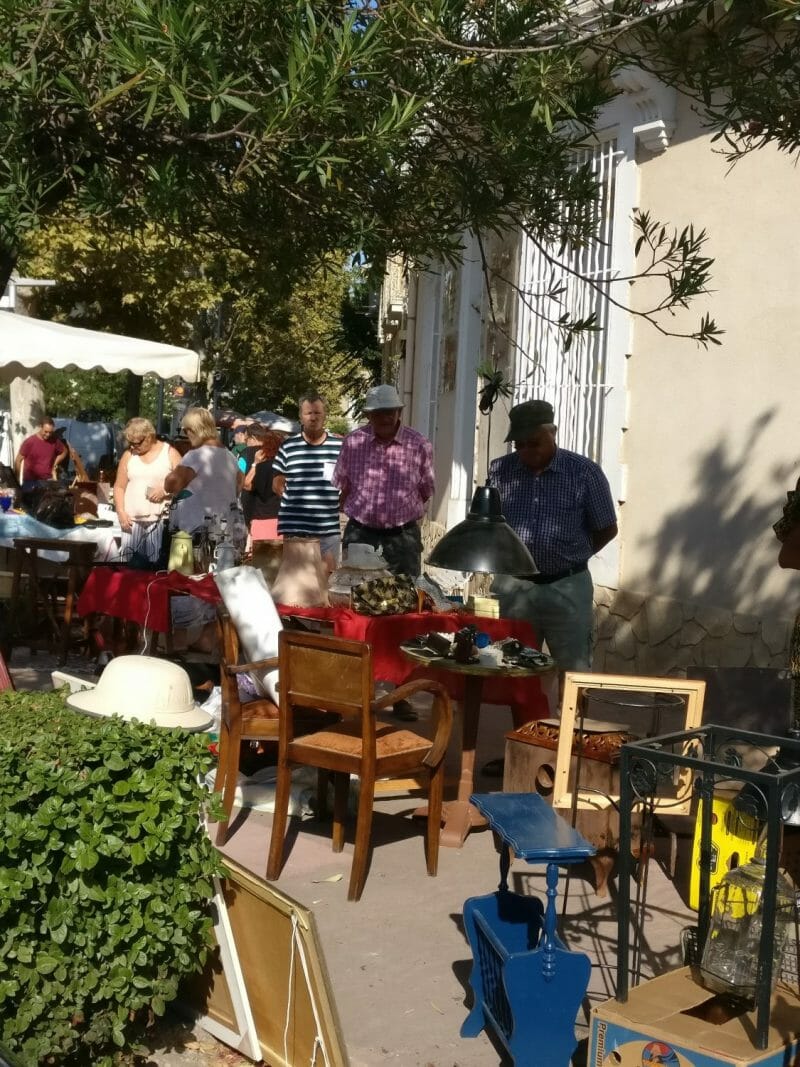Another afternoon, driving back from les Saintes Maries de la Mer – a village all bright and dazzling by a windy sea, with narrow fisherman’s lanes, a pretty restaurant beneath a mulberry tree, women in gypsy dress offering lavender, and such views of the Camargue from up on the church roof – I saw a sign pointing up a sandy lane beside riding stables, white horses tethered in the shade. “Antiquités brocante“. What fine words. We drove up to a large Mas, the farmhouse, sun-baked and stately, oleanders around the gravel terrace with pretty green garden table and chairs. A cat casually came to inspect us, but the place was otherwise still and shut. Down at the end of the lane again a man in the stables waved at us. “Vous etes marchand?” he called. “Go back to the house and I will open the shop for you.” In fiveminutes he had arrived and swung back a set of doors revealing the shop sign and the magical word, always a pleasure to find in France, “Ouvert“.
A wooden staircase and landing had been constructed to lead the willing customer down into a cellar. Dust and cobwebs indicated stagnation rather than abundant mysteries to be explored. Nevertheless in a large cupboard I found the entire works of Alexandre Dumas, bound in pale faded green 19th century paper. A price was agreed and the pile carried out into the hot sun. “I have another barn with many items for restoration,” he said, “but I do not have the key at this moment. Perhaps you can return another time?” He had to leave us then and said to be sure the cat hadn’t jumped into the van before we left.
Liz came with me to the Beziers Deballage. This time I was primed to come off the autoroute at the right exit and we got to the Parc des Expositions in time to join the crowd of international dealers waiting for the 8am surge through the gates. Once inside we went straight into one of the big halls and picked our way around the disarray of vans, crates, boxes and flurries of bubblewrap. Vendors hurriedly unloaded commodes, tables, bureaux, vitrines. Gusts of vehement Italian burst from the back of a van in all the rush. Some items were immediately pointed out and noted down as sold for shipping. Things would settle down in a little while and the buying would be less frenetic.
There were familiar faces here and lovely things to buy. A pair of circular Italian gilded and painted cabinets; a coffer for storing lace, covered with vivid blue flowered 19th century paper; still lives of quince fruit on a platter, of anenomes in a jug against a blue wall; chandeliers gloriously catching the light; ‘boutis‘ quilts of faded pink Toile de Jouy stuffed with lambswool and stitched into scrolls and patterns; stacks of heavy white ceramic platters and soupieres; large pale yellow confit pots….. More than enough to please the eye and start filling the van.
We went to collect the little coffer in good time as the dealer had told us she was leaving early. There was only a heart sinking gap in the row of dealers….. ‘She has just gone,’ said a neighbouring dealer.
Thierry at the main entrance said he would phone Eliane, the dealer, and we could sort something out. And that evening I spoke to Eliane. She had forgotten all about the coffer, she was ‘desolée‘. She would not be at the next two fairs, she said, so she would post it to me. ‘Je suis une marchande tres serieuse,’ she assured me. (The coffer arrived safely in England some days later – worn and beautiful).
The real Sylvie, my van’s namesake, had driven down from Normandy with Jean, her husband, and we exchanged notes on purchases as the morning progressed. If I needed extra space, Sylvie had offered, she could transport items up to her depot for me to collect on a quick Channel hop later.




